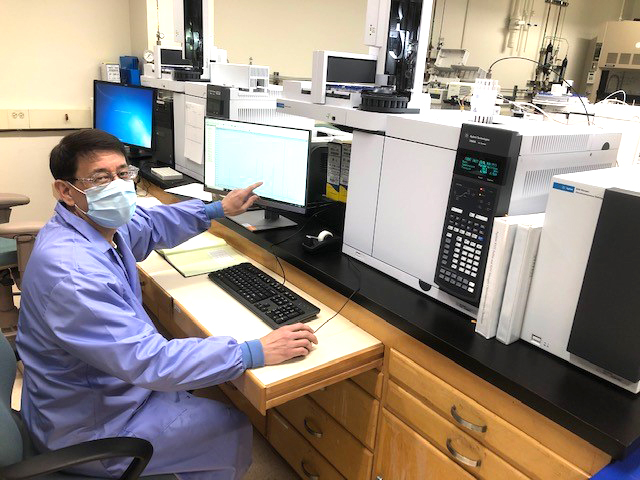LLNL's Forensic Science Center earns 'A' grade in OPCW environmental test
 (Download Image)
(Download Image)
Lab Forensic Science Center analytical chemist David Cho utilizes state-of-the-art, two-dimensional gas chromatography-time of flight mass spectrometry to analyze complex samples for the Organisation for the Prohibition of Chemical Weapons 48th proficiency test. The mass spectrometry technique has a huge capability to separate complex mixtures.
This fall, a score of scientists from Lawrence Livermore National Laboratory's (LLNL) Forensic Science Center (FSC) will start two weeks of long days to undertake the Organisation for the Prohibition of Chemical Weapons (OPCW) environmental proficiency test.
Livermore scientists have been taking the proficiency tests each October since 2001, with LLNL serving as one of two United States laboratories certified to test for chemical weapons since 2003.
“Each year, we become a little anxious as the proficiency test date nears and we start to prepare our instrumentation and our quality control samples,” said Armando Alcaraz, the principal investigator for the Lab’s OPCW efforts since 2001.
“But there’s also the excitement and challenge of working to do our best possible job to identify the unknowns that are in the samples.”
Every October, Livermore scientists and those from other laboratories around the world attempt to identify any “suspected” chemical weapons compounds in six samples within the 15-day period of the proficiency test.
To retain their OPCW certification, LLNL and other OPCW-designated laboratories must maintain a three-year rolling average of at least two “A” grades and one “B” in the ongoing tests.
“The chemical analysis capability that is exercised through the OPCW proficiency tests is foundational to much of the research and real-world sample analysis we perform in the FSC,” said FSC Director Audrey Williams.
In last fall’s 48th OPCW environmental proficiency test, the FSC team earned an “A” grade for the 11th straight year.
The test started last Oct. 22 when six samples were shipped to the FSC laboratory: three hand sanitizer samples and three body oil samples.
“This was another very challenging proficiency test that had a realistic test scenario,” Alcaraz said. “The test sample matrices were collected from a suspected poisoning of two victims who had skin contact with these materials.
“The samples were chemically complex, as they contained high concentrations of naturally occurring interferences, including glycerin in the hand sanitizer and oleic acid in the body oil samples.”
The Livermore researchers correctly identified all six reportable spiked chemicals, which were at trace levels or very low concentrations, making the detection that much more challenging, according to Alcaraz.
“The interferences had very similar chemical properties in some cases in comparison with the reportable chemical, so that made isolating the chemicals that much more problematic.”
LLNL Forensic Science Center analytical chemist Roald Leif analyzes data collected on a gas chromatograph-mass spectrometer for the Organisation for the Prohibition of Chemical Weapons 48th proficiency test.
During last October’s test, the LLNL forensic scientists not only had to correctly identify the reportable chemicals but also were required to perform their collaborative work with added precautions because of the SARS-CoV-2 pandemic.
“We implemented a variety of new procedures for undertaking the OPCW proficiency test because of COVID-19 and had to have those procedures approved by Global Security and Lab management,” Alcaraz noted.
The team of chemists found a large room in Bldg. 132 North that could accommodate the whole research team with six-foot social distancing, and all team members used N-95 protection masks. The researchers’ desks were each contained within full glass partitions, with sanitizers and gloves.
LLNL received its original OPCW certification in 2003. Its work is carried out by the Laboratory's FSC, which is part of the Global Security Principal Directorate and is funded by the National Nuclear Security Administration’s Office of Nuclear Verification.
The other U.S.-designated laboratory is the Aberdeen Proving Ground, Maryland-based U.S. Army Combat Capabilities Development Command Chemical Biological Center (formerly Edgewood Chemical Biological Center).
The OPCW oversees compliance for the Chemical Weapons Convention (CWC) treaty, which has been in force since 1997 and currently has 193 nations or state parties.
Under the CWC, the development, production, acquisition, stockpiling and use of chemical weapons is banned, as is the transfer of chemical-weapon-related technologies.
The samples for last October's proficiency test, taken by LLNL and 21 other laboratories around the world, were prepared by the OPCW laboratory in The Hague. The participating laboratories' test reports were then evaluated by The Laboratory of Toxicant Analysis, Academy of Military Medical Sciences, in China.
Out of the 22 laboratories that participated in the October OPCW proficiency test, 19 earned “A” grades, two garnered “B” grades and one received a “C”.
Three of Livermore's “A” grades over the past 11 years, including its 2018 grade, have been received for serving as the OPCW's evaluation lab, grading proficiency test reports.
In addition to Alcaraz and Williams, other Lab researchers participating in last fall’s OPCW proficiency test were Deon Anex, Sarah Chinn, David Cho, Todd Corzett, Mark Dreyer, Carolyn Fisher, Saphon Hok, Rebecca Johnson, Carolyn Koester, Roald Leif, Katelyn Mason, Brian Mayer, Tuijauna Mitchell-Hall, Michael Riley, Edmund Salazar, Robert Schmidt, Carlos Valdez and Alexander Vu.
Contact
 Stephen Wampler
Stephen Wampler
[email protected]
(925) 423-3107
Related Links
NNSAChemical Weapons Convention
“The Worldwide Effort to Ban Chemical Weapons”
“Ready to Respond to Chemical Weapons"
Tags
Nuclear, Chem, and Isotopic S&TNuclear and Chemical Sciences
Physical and Life Sciences
Threat preparedness
Biosecurity
Counterterrorism
Defense
Nonproliferation
Strategic Deterrence
Featured Articles








